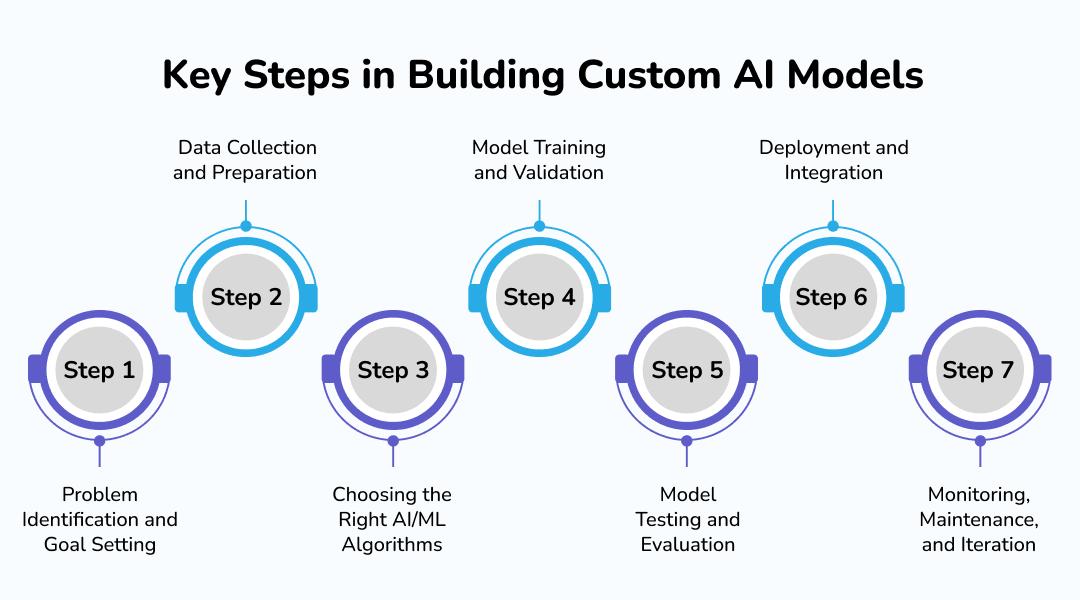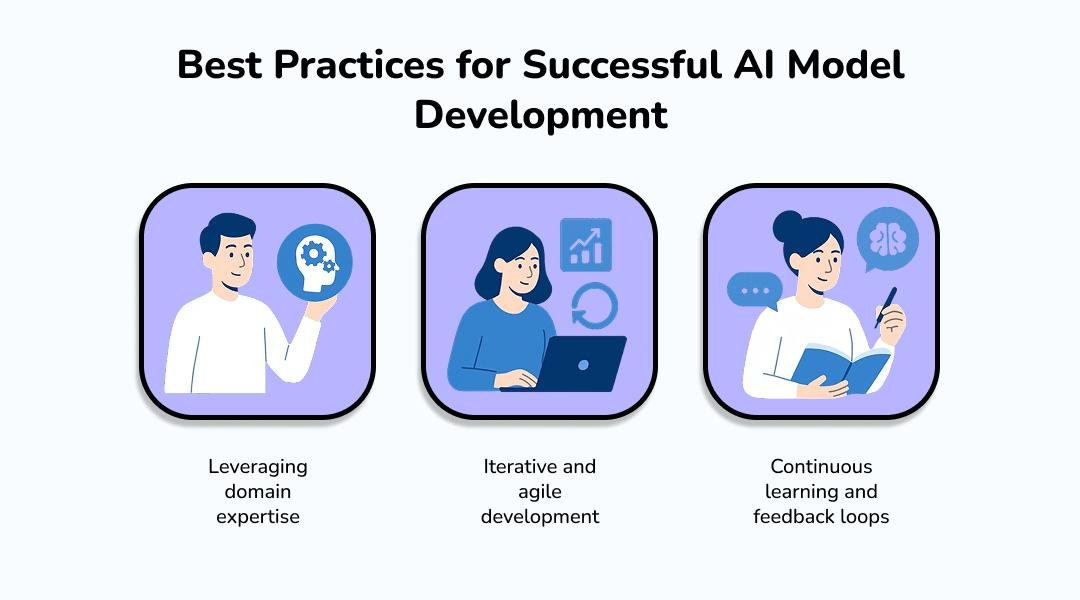Building Custom AI Models: Key Steps and Challenges
I’ve been in the trenches of AI development long enough to spot a common pattern: businesses dive headfirst into AI projects, only to stall halfway, frustrated and unsure why. If you’re reading this, chances are you’re thinking, “I need AI for my business, but where do I even start?”
Let me save you some headaches. Building custom AI models isn’t about hype. It’s about understanding your problem, your data, and your goals and then translating that into a machine that actually works for you.
This guide isn’t theoretical. I’ll walk you through the steps I’ve followed with clients at KriraAI, the challenges we’ve faced, and the strategies that consistently deliver results.
Understanding Custom AI Models
What is a custom AI model?
A custom AI model is…well, custom. Unlike pre-built AI tools that do one thing “out of the box,” a custom model is designed specifically for your business problem. Think of it as tailoring a suit versus buying one off the rack. One fits perfectly; the other might look okay but will never feel right.
It could be anything from a predictive sales model for your e-commerce store to a recommendation engine that actually understands your users’ tastes—or a complex computer vision system for manufacturing quality control. The key: it solves your unique challenge, not a generic one.
Difference between pre-built AI tools and custom AI models
Pre-built AI tools are tempting, they’re fast, cheap, and marketed as plug-and-play. But here’s the catch: they rarely match your specific data, workflow, or objectives. Custom models? They take longer, cost more upfront, but the ROI is often far higher because they’re actually useful.
Key Steps in Building Custom AI Models

Step 1: Problem Identification and Goal Setting
Before touching a single line of code, you need clarity. What problem are you solving? Is it reducing churn, automating customer support, predicting machinery failure? The goal needs to be measurable. Vague objectives like “improve efficiency” won’t cut it.
Ask yourself:
What does success look like?
How will this AI interact with existing systems?
Are we solving a core problem or just experimenting?
Step 2: Data Collection and Preparation
Here’s where most projects stumble. No data. Bad data. Incomplete data. I’ve seen companies pour thousands of hours into model training, only to realize their dataset was inconsistent or biased.
Data preparation isn’t glamorous, it’s tedious, but it’s the foundation. You’ll need:
Quality datasets with clean, relevant, and labeled information.
Data augmentation for scenarios where you don’t have enough examples.
Feature engineering to highlight the patterns your model should learn.
Remember: garbage in, garbage out.
Step 3: Choosing the Right AI/ML Algorithms
There’s no one-size-fits-all algorithm. Neural networks, decision trees, gradient boosting—each has strengths and weaknesses. My advice: don’t chase novelty. Choose algorithms suited to your problem, your data size, and your computational resources.
(Pause here: Are you imagining some magical AI that picks the right algorithm for you? Nope. That’s your job or your data science team’s.)
Step 4: Model Training and Validation
Training the model is like teaching a kid: you show examples, correct mistakes, repeat. Split your dataset into training and validation sets. Track performance metrics carefully.
Pro tip: don’t obsess over perfection in early iterations. Focus on consistent improvement. Iteration beats a one-shot miracle model every time.
Step 5: Model Testing and Evaluation
Testing is where many teams crash. It’s tempting to test only on data the model has seen, but that’s lying to yourself. Use unseen test data to evaluate real-world performance.
Watch for:
Overfitting – model memorizes instead of generalizing.
Underfitting – model fails to learn patterns at all.
Bias – model performs poorly for certain user groups.
Step 6: Deployment and Integration
Congratulations. Your model works. But now comes the real challenge: putting it into production. Deployment isn’t just about running code—it’s about connecting your model to APIs, databases, and user interfaces.
Tip: Deploy incrementally. Monitor closely. Expect hiccups.
Step 7: Monitoring, Maintenance, and Iteration
AI models aren’t static. Data changes, business priorities shift, and performance degrades over time. Set up monitoring systems and schedule regular model reviews. Continuous iteration is non-negotiable if you want lasting impact.
Common Challenges in Custom AI Model Development
Data quality and quantity issues
Sparse, messy, or biased data can derail even the most sophisticated model. Address this upfront.
Model overfitting and underfitting
Overfitting is the silent killer. Underfitting is obvious, but equally deadly. Both can waste months.
Computational resource limitations
High-end models need high-end hardware. Not every business can afford GPUs or cloud computers. Plan realistically.
Integration with existing systems
Your shiny new AI must play nicely with legacy databases, CRMs, or ERP systems. That’s where 70% of deployment headaches occur.
Security, privacy, and compliance concerns
AI deals with data. Sensitive data. Regulatory compliance isn’t optional. Plan for encryption, anonymization, and audits from day one.
Best Practices for Successful AI Model Development

Leveraging domain expertise
Don’t build in isolation. Involve business users, analysts, and engineers. Domain knowledge often trumps algorithmic complexity.
Iterative and agile development
Small, testable increments beat giant, monolithic projects. Ship, measure, tweak, repeat.
Continuous learning and feedback loops
Even deployed models should evolve. Feed new data, monitor errors, and continuously improve performance.
Conclusion
Building custom AI models isn’t a mystery. It’s a disciplined process with clear steps: define the problem, gather and prep data, pick the right algorithms, train, test, deploy, and iterate.
Yes, it’s complex. Yes, there will be challenges. But with the right approach and sometimes a trusted partner like KriraAI, AI stops being a gamble and starts being a tool you can count on.
Custom AI models can transform businesses, but only if you respect the process. No shortcuts. No hype. Just results.
FAQs
Costs vary widely based on complexity, data volume, and integration requirements. A mid-sized business can expect anywhere from $20,000 to $150,000 for a fully deployed, custom AI model.
Typical timelines range from 3 to 9 months. This includes problem definition, data prep, model training, testing, deployment, and iteration cycles.
Only if your business benefits from content generation, simulations, or predictive modeling that requires creative outputs. Otherwise, simpler AI models may be more efficient.
Common challenges include data quality issues, model overfitting, insufficient computational resources, system integration, and regulatory compliance.
Start by understanding your problem type (classification, regression, clustering). Then evaluate algorithms based on dataset size, complexity, and business requirements. Domain expertise is crucial here.

CEO
